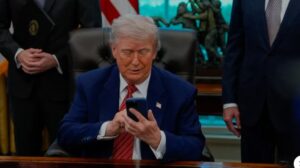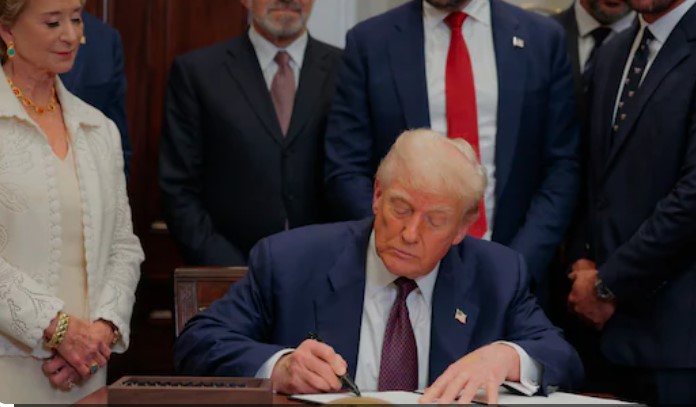For quite some time, the Trump tariffs have dominated the economic and political discourse, reshaping the international trade environment and triggering debates on a range of issues. The knowledge of tariffs and how they affect economic activity is important to every business owner, policymaker, and consumer. In this blog, we will discuss the origins, effects, and controversies of Trump’s trade policies as well as the latest tariff news.
Tariffs: What Are They and Why Are Rates Set?
A government imposes a tariff as a tax on international goods, mainly to protect domestic industries or raise revenue. Sometimes, governments also use tariffs as bargaining chips in trade negotiations. Tariffs can affect almost everything—from the price of food at Walmart to the cost of automobiles made abroad.
Tariff Information Label: The outcome, essentially, has been price increases for merchandise subject to tariffs, which sometimes trickle down to the final retail prices that consumers pay.
Trump Tariffs, in Short.
What does an Australian dance sound like? Well, the first half of the dance involves simply hopping from foot to foot, or, as danced in the US, it means hopping onto one foot, then the other. Trade disputes were arising and affecting the whole US economy; tariffs were the manifestation of the discord. Tariffs set in by the Trump administration targeted China, Canada, and the EU, including agriculture, steel, technology, and autos.
The main highlights are:
- China Tariffs on US: Trump levied tariffs on Chinese goods worth billions of dollars, and China retaliated with a similar tariff attack.
- Canada Tariffs: Tariffs were levied on steel, aluminum, and certain agricultural products from Canada, thereby straining relations between neighbors.
- Auto Tariffs: Trump threatened to apply tariffs to automobile imports on the grounds of coercing U.S. national security, and, in some cases, he implemented such tariffs.
Auto Tariffs: A Winnowing Instrument for the Automobile Industry
One of the more hotly debated aspects involved the discussion about auto tariffs. Imported vehicles from Europe, Japan, and Canada were to face potential tax hikes; this policy:
- Increases production costs for automakers.
- Vehicle prices for American buyers have been raised.
- Gives some companies the incentive to move some of their production into the U.S.
To the average car buyer, these tariffs meant a sudden jump in car prices. Meanwhile, for manufacturers, it became a question of global competitiveness.
🇨🇦 Canada Tariffs, and the Cross-Border Trade
Okay, so what this did to the tariffs with Canada put strain on one of the closest trade relationships in the world. Canadian exports of steel and aluminum were pretty much devastated, forcing Canada to retaliate with a slew of its tariffs targeting U.S. goods-from agricultural products to consumer goods.
For businesses whose supply chains are cross-border, this was a huge disruption. Small businesses had to pay more, while large corporations had to amend their original sourcing and production plans.
Walmart Tariffs: The Retailing Domino Effect
With the Walmart Tariffs generated, Big retailing was directly affected because many of the goods they sell are sourced from countries targeted by Trump’s trade policies. This brought about:
- Rising consumer prices.
- Shifts in sourcing strategies.
- Considerations about inflation and the purchasing power of the average American.
For example, the retail giant Walmart was used as a case study for the effects of tariffs on the very nature of everyday shopping.

China Tariffs on the US: Retaliation and Global Fallout
China’s imposition of tariffs on US goods elevated the trade dispute into a full-blown conflict. China went for American agriculture, especially soybeans, pork, and other farm produce, hurting U.S. farmers. The contrashocks extended to the technological and energy-related disciplines, with the resulting economic slowdowns affecting and being experienced by both countries.
Moreover, this tit-for-tat tariff war created uncertainty in the global market, shaking investor confidence and creating instability for businesses dependent on international trade.
Tariff News: The Latest Developments
Prices may be around lately since Mr. Trump has left the White House. However, most of his tariffs persist, and whether to roll them back or expand them remains a hotly contested debate. The Biden administration has reviewed some of these policies, but international trade tensions remain sky-high.
Some of the big updates:
- Discussing lowering some tariffs to fight inflation
- Negotiations related to trade agreements with China are still ongoing
- Concerns about rising supply disruptions because of continuing tariffs
How Tariffs Affect Ordinary Consumers
Tariffs might sound like an elective policy issue. However, there is something about them that affects everyday life. Here is how:
- Higher Prices: A tariff increases the prices of exports for the importers, from groceries to cars.
- Lesser Choices: A Lesser amount of imports may mean fewer choices for consumers.
- Uncertainty: Uncertainty causes businesses to lay off workers and to increase prices to absorb tariff costs.
Similarly, Walmart shoppers began facing increasing prices for everyday goods due to rises in import costs. US farmers,s meanwhile, saw a drop in overseas demand due to retaliatory tariffs.
The Political Debate Surrounding Trump Tariffs Policies
Tariff proponents argued that Trump tariffs were needed to protect American jobs, reduce trade deficits, and force fairer trade deals. Their opponents mentioned the increased costs for consumers and businesses, the threat of trade wars, and the frayed relations with allies such as Canada.
The Global Interface of the Trump Tariffs
Experts consider the tariff measures as the ones triggering action internationally:
- The Chinese Economy: Tariff measures slowed down growth and forced some policy changes.
- Canada Tariffs: Invoked retaliation and disruption to North American trade.
- Europe and the Auto Industry: They were hit by threats of tariff imposition, casting uncertainty.
At that time, disruptions shook global supply chains, pushing firms to rethink where and how they sourced products.
Trump Tariffs: What the Future Holds
The Trump tariffs gave new shape to global trade and engendered a debate that rages even at the present. Supposedly protecting U.S. industries from foreign competitors, they ended up costing higher prices for consumers and retaliation from trade partners, besides creating long-term economic uncertainty. One thing is clear: whether tariff news is being followed or the latest news on the auto tariffs is being checked for, or if in everything money is put into watching China tariffs on US goods-tariffs will remain at the centre of any trade policy debates.
Businesses and consumers continue to adapt, now more than ever, with tariff information and how global policies impact local realities, having to stay current with all this. In a world where trade wars sometimes start with the stroke of a pen, very few things can protect you but knowledge.


